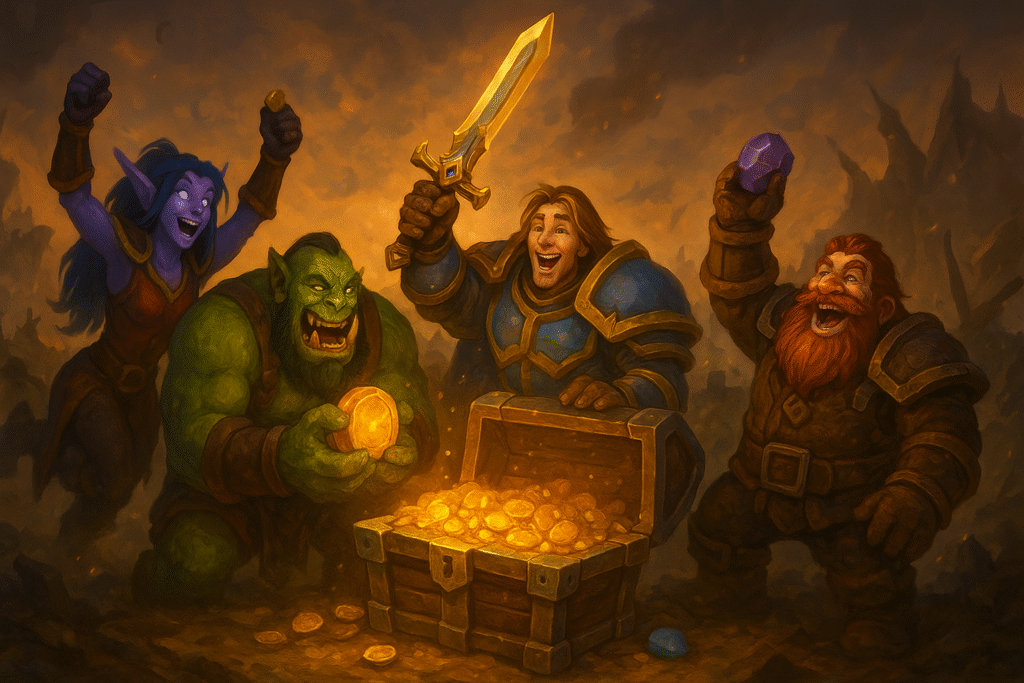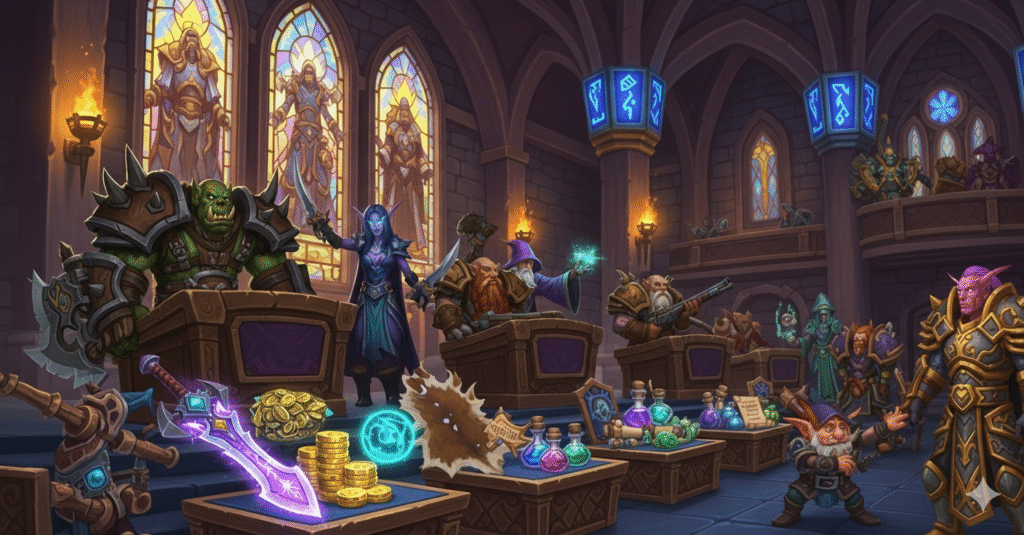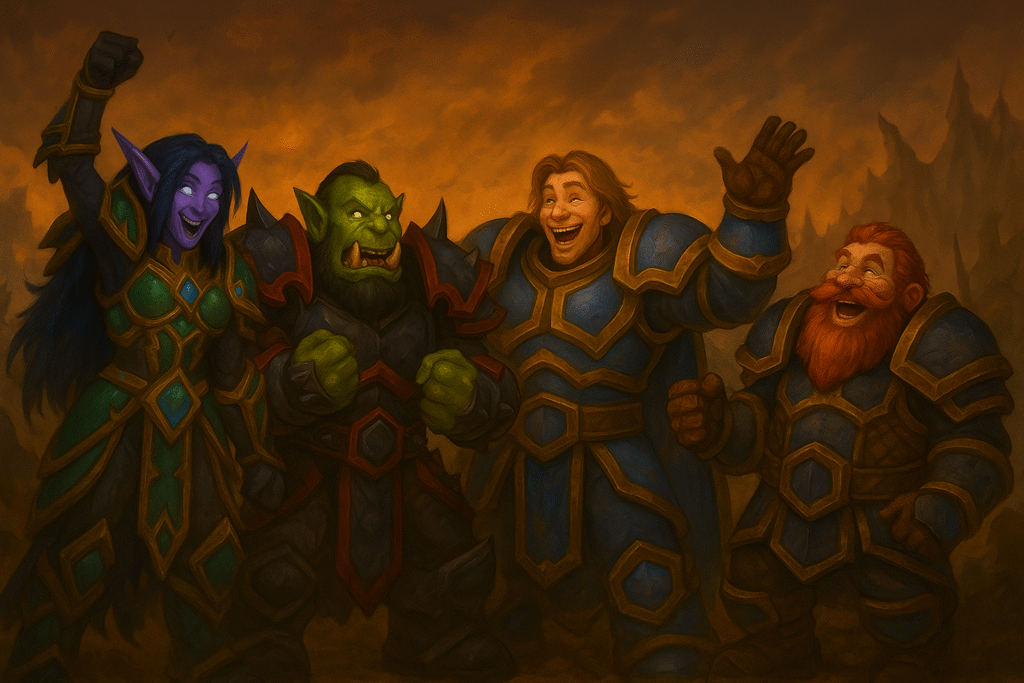Are you gonna keep that axe?

Loot is one of the main and most consistent forms of progression in World of Warcraft so it’s no wonder that any player you ever meet in that game has fallen in love with the concept of it. And here’s the kicker — even after nearly two decades of WoW, that thrill of seeing a purple item drop hasn’t gone away! But why does loot matter so much? In this article we will dig into the reason why so many players are willing to repeat the same dungeons and raids as many times as they physically can in order to get that sweet sweet loot.
If you’re one of those people that just can’t get hooked on the concept of repeating content, but you do still love the loot cycle, then you should consider services like the Manaforge Omega Raid Boost. Skip the stress and get right to the rewards!
Loot as Progression
At its most basic, loot is the clearest sign of progression in WoW. Leveling up your character feels good, but eventually, you hit max level. From that point on, the main way you “grow stronger” is through gear. Each new item is a visible and tangible upgrade — it makes your character hit harder, heal more efficiently, or survive incoming damage more easily.
That steady march of item levels is addictive! Even small upgrades give you a noticeable boost, and suddenly you’re able to handle harder dungeons, contribute more in raids, or dominate in PvP. Gear becomes the visible marker of your time and effort. It’s like a badge that says, “Yes, I put in the work, and here’s the proof.”
The Thrill of the Drop
Let’s be honest — nothing in WoW compares to that moment when a boss finally drops the item you’ve been farming. The anticipation, the suspense, and then the sheer excitement when you see that loot window pop up with the right piece. It’s dopamine in digital form!
This is what psychologists call variable ratio reinforcement — the same mechanic that makes slot machines addictive. You don’t know when the reward is coming, but you know it might happen every time. That uncertainty makes every kill, every dungeon, and every chest feel exciting. Even when you don’t get the drop, the possibility keeps you coming back. And when you finally score that long-awaited item? The emotional payoff is huge.
Loot as Status
Loot isn’t just about power — it’s also about status. Some pieces of gear are iconic. Think of Thunderfury back in Classic WoW, Warglaives of Azzinoth in Burning Crusade, or Shadowmourne in Wrath. These weren’t just items; they were symbols. Seeing someone with one instantly told you: “This player has put in serious time and effort.”
Even today, rare mounts, transmogs, and raid tier sets serve as markers of prestige. A flashy set of shoulders or a glowing weapon can tell a whole story about where you’ve been, who you’ve defeated, and how skilled (or persistent) you are. For many players, showing off loot in Orgrimmar or Stormwind is half the fun!

Loot Drama: When Desire Meets Distribution
Of course, where there’s loot, there’s drama. WoW has seen every type of loot dispute imaginable — ninja looting in dungeons, raid groups arguing over who gets what, and even entire guilds imploding over a single item. Why does this happen? Because loot isn’t just pixels; it’s personal investment. Players pour hours into chasing items, and when they feel cheated out of a reward, emotions run high.
Loot systems like need/greed rolls, master loot, and personal loot have all tried to solve the fairness problem, but none have completely eliminated tension. And that’s because gear carries both practical value (power) and emotional value (recognition, status). Losing out on loot feels like losing out on progress — and nobody likes that.
RNG vs. Deterministic Rewards
Over the years, Blizzard has experimented with how loot is distributed. Sometimes it’s all about RNG (random number generator) — you kill a boss, and maybe you get lucky. Other times, systems like badges, tokens, or Great Vault-style rewards give players more control over their upgrades.
Players have strong opinions here! Some love the thrill of RNG and the joy of unexpected loot, while others prefer the security of knowing they’ll earn upgrades steadily over time. The truth is, WoW thrives on balancing both. RNG keeps the excitement alive, but deterministic systems prevent burnout when luck isn’t on your side. Without that balance, loot can feel either too frustrating or too routine.
Loot as Identity
One underrated aspect of gear is how it lets players express themselves. Transmog opened the floodgates on this idea — suddenly, gear wasn’t just about stats but about style. Players could curate their character’s look, mixing and matching sets, weapons, and even goofy outfits. For many, transmog hunting is as important as raiding!
But even beyond cosmetics, gear defines your character’s identity. A healer with the right trinkets plays differently than one without. A DPS with a certain legendary weapon has a whole new toolkit. Gear doesn’t just boost your numbers — it shapes your playstyle and role in the group. That personalization makes loot incredibly meaningful.
Loot in Modern WoW
In Dragonflight, loot still rules. Mythic+ dungeons keep players grinding keys for that perfect trinket or weapon, while the Great Vault provides a weekly layer of anticipation. Raids continue to be about more than just boss kills — they’re about getting the set pieces, weapons, and unique drops that define your character’s power for the tier.
What’s interesting is how Blizzard has made loot more accessible (badges, tokens, weekly chests) while still preserving the chase. It’s a tightrope walk between keeping loot exciting without making it frustrating. And judging by how players still obsess over gear, the system works.

In Conclusion
At the end of the day, gear isn’t just about numbers — it’s about psychology. It taps into our love for progress, status, identity, and surprise rewards. It creates stories, from the elation of your first legendary drop to the drama of losing a roll on a coveted item.
Loot is the thread that ties WoW’s gameplay together. Quests, dungeons, raids, PvP — they all feed back into the desire for better gear. And while WoW has countless systems layered on top (mounts, achievements, storylines), it’s loot that consistently pulls players back week after week, expansion after expansion.
So next time you cheer because a boss finally dropped your item, know that you’re not just celebrating pixels. You’re experiencing one of the most powerful design elements in gaming history — the psychology of loot. And let’s be honest, no matter how many expansions come and go, we’ll always be chasing that next upgrade!